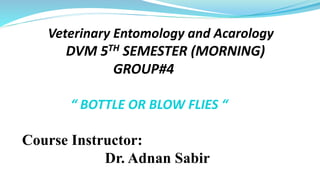
Bottle or blowflies presentation-1.pptx
- 1. Veterinary Entomology and Acarology DVM 5TH SEMESTER (MORNING) GROUP#4 “ BOTTLE OR BLOW FLIES “ Course Instructor: Dr. Adnan Sabir
- 2. • GROUP #4 MEMBERS SYED ABDUL WAHAB GILANI 67 SIDRA MUSHARRAF 39 UROOJ QADIR 47 HAZIK ABDULLAH 36 M. ABU BAKAR 40 M. AHMAD 37 MOHSIN IRSHAD 23 SARMAD SHABBIR 42 ARSLAN ASLAM 62 ALI HASSAN 50 SHERAZ RABANI 02 Names Roll No. SYED ABDUL WAHAB GILANI 67 SIDRA MUSHARRAF 39 UROOJ QADIR 47 HAZIK ABDULLAH 36 M. ABU BAKAR 40 M. AHMAD 37 MOHSIN IRSHAD 23 SARMAD SHABBIR 42 ARSLAN ASLAM 62 ALI HASSAN 50 SHERAZ RABANI 02
- 3. Contents:- Taxonomic Classification Host spectrum Morphology Life Cycle Site of infestation Pathogenesis Diagnosis Treatment Control measures Public Health Significance
- 4. Taxonomic Classification CLASS : Insecta Order : Diptera Family : Calliphoridae (bottle or blow flies) Important Species : Lucilia (Green or Copper bottle Fly) Phaenicia ( Green Bottle Fly ) Phormia ( Black Blow Fly ) Calliphora ( Blue Blow Fly )
- 5. HOST SPECTRUM o Any animal with wounds , soiled , malodorous or necrotic tissue INTERMEDIATE HOST A nematode Syngamus trachea (Gapeworm) infects trachea of birds Cause respiratory distress in bird lead to death This nematode use larvae of Lucilia sericata as an intermediate host Turkeys and chickens are most common birds that infected
- 6. MORPHOLOGY Lucilia Bright metallic colors like bright green or bronze color Eyes brownish red Body slender 8-10mm long Calliphora erythrocephala Large stoutly body about 12 mm long Red eyes Genae red with black hairs Buzzes loudy
- 7. MORPHOLOGY Phormia Flies 6-11 mm long Thorax black with metallic blue-green sheen Abdomen blue green to black Deposits egg in the wool of sheeps
- 8. MORPHOLOGY Larvae : • Greyish white or pale yellow • 10-14mm long • Pointed anterior end with oral hooks • Flat posterior end with spiracular plates • Usually bristly - row of bristles on Hypopleuron
- 9. SITE OF INFESTATION Wounds on necrotic areas Skin soiled with urine , feaces and vomitus Factors influencing calliphorine myiasis in sheep are classified in two groups : Prevalence of flies Suspectibility of sheep
- 10. Prevalence of Flies Most abundent – late spring and early summer Adult flies feed on liquified protein and necter Protein food helps in maturation of ovaries and fertility Larvae get food from living sheep and dead carcasses Classified as Primary , secondary and tertiary flies
- 11. Primary Flies : • They initiate a strike by laying eggs on living sheeps • Larave develop autolytic and bacterial decomposition e.g Lucillia cuprina Secondary Flies : • They lay their eggs on sheep already struck and the larave extend the injury done by the larvae of primary flies • Larave develop during succeeding phase of liquefaction e.g Chrsomyia micropogon
- 12. Tertiary Flies : • It comes last of all and the larave do a little further damge • Larave develop when carcass begin to dry out e.g Musca domestica
- 13. Susceptibillity of Sheep It depends on two factors : • Inherent Factor • Temporary factors Sheep are frequently struck in breech (crutch strike) and around the tail ( tail strike ) Poll Strike : Rams with deep head folds or horns lying close to the head causes sweaty condition of skin that attracts blowflies strike in that region
- 15. Life Cycle of Bottle Fly • Clusters of light yellow eggs • 1000-3000 eggs altogether • 50-150 eggs in one batch • meal of protein is required to reach ovaries full maturity • 8 hrs to three days for larval hatching
- 16. • Mature larvae leave the host to pupate in the ground • Pupal stage lasts 3-7 days in summer • But much longer in winter • Hibernation also occurs in this stage. • The shortest time of completion of life cycle is 7 days. Life Cycle of Bottle Fly
- 17. PATHOGENESIS Larvae are saprophagus , flesh feeders or parasites Causes facultative myiasis Form deep tunnels in tissues Causes anorexia , weakness and secondry bacterial infection Death occur due to toxemia and septicemia Lucillia larvae causes blowfly strike L.sericata found in human wounds
- 18. PATHOGENESIS Animal stand with head down and doesn’t feed If lesion is on tail, animal will wage the tail There will be a patch of discolored greyish brown moist wool with evil odor Maggots may be found attacking the skin and may crawl away Later on inflamed ragged wound may be observed with foul smelling exudate
- 19. Pathogenesis • In severe cases, malnutrition and milk loss are observed and might be fatal Lightning strike • A condition observed in Australia in sheep resulting in death within a few days due to bacteria causing septicemia or toxemia
- 20. DIAGNOSIS o Clinical signs o Identifying the larvae TREATMENT o Clip hair or wool to determine the extent of lesion o Remove the larvae o Apply wound dressing not toxic to host : • Promotes healing • Contain small amount of insecticide
- 21. CONTROL MEASURES Selective Breeding Proper disposal of Carcass Dehorning , Branding , ear marking avoided in fly season Carefully examine and clean new borns Remove skin folds and wool from the urogenital area of sheep Sterile male Technique
- 22. Public Health Significance o Human may be infested o Maggots of this group used in wound therapy to promote : • Healing • Deter infection
- 24. Any Questions?